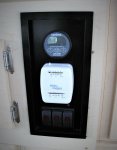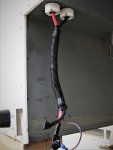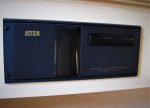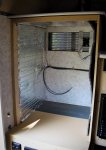Electrics - On the Home Stretch for this Year!
With the CTEK module doing its magic, new heavy wire allowing the pixies to slide down the tube more easily and the Xantrex monitor keeping a watchful eye on the ever reluctant pixies, I'm pretty happy with the way the Tundra and Grandby are working together to keep the house batteries charged. But, I'm not totally out of the woods yet.
Part of the plan is to be able to drive into the backcountry, turn the key off and chill for a few days. You're reading this on an overland forum; you know exactly what I'm talking about. Another cup of coffee in the morning, napping in the afternoon, lazy evenings around the campfire. Wait, I lost my train of thought there for a moment. Back on track White Dog.
Because I can now watch how many amps are going into and out of the batteries thanks to Mr. Xantrex, I can watch the performance of the solar panels. I have two 100 w monocrystalline 12 VDC panels mounted on the roof. The manufacturer rates these at 5.52 amp 'Maximum Power Current (Imax)' output. Together, the theoretical maximum should be 11 amps. In the real world, the theoretical maximum in never reached (its a long and complicated story). However, 9 amps shouldn't be unreasonable if the panels were at the perfect angle to the sun. Mine are flat so 7 amps would be a reasonable number. Building an easy system to tilt the panels is a future project. Any examples out there other than the usual arms and bolts systems? Anyway I had never seen my panels put out more than 5.5 amps. Another stumper.
The problem became clear when I realized FWC hid a the junction box for the solar panel (and all the ceiling electrics) underneath the forward lift panel. Taking the lift panel off (6 screws) gives complete access to the box. The wires from the panels to the connecter on the roof were 10 ga. but the in the junction box FWC had reduced the wire size to 14 ga., way to small for my panels. This is kind of strange actually. I would have suspected 12 ga. for the original 90 watt panel. I would have been happier if they had used 10 ga. which is kind of the norm but there you go. I suspect that the technician at the factory just installed the wrong gauge by mistake but that's speculation.
At this point, it is probably obvious that our old and dreaded enemy, voltage drop, is making another appearance. Gad I hate that guy. The run from the panels to the CTEK unit was just short of 25', a long haul. For 14 ga. wire, I calculated the voltage drop would be about 13% at 8 amps. You can actually measure the drop by putting a multimeter set to DCV across the solar panel leads where they come out of the panel and compare that to the voltage at the input for the CTEK charger. My estimate of 13% was pretty close to the measured loss. Effectively, I was loosing about an amp to voltage drop. I told you I hated that guy.
So what to do?
A quick calculation showed that to keep the voltage drop to 3% I needed to have 10 ga. wire. The problem was how to get it from the solar panels to the batteries. For those of you that don't know, FWC runs all the electrical wires from the junction box under the lift panel forward above the headliner then behind the forward folding panel, out from behind the panel , behind the trim panels on the left side and finally behind the plywood paneling behind the kitchen cabinets. I can show part of this run.
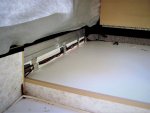
My problem was how to run the new heavier wire through the ceiling. The headliner cannot be easily removed. I was told that if I were lucky, the technicians at the factory wouldn't have attached the wires anywhere along the ceiling run and I could just attach the new wires to the ends of the old ones at the junction box and pull them through. Any guesses how that went. My dad was lucky. My sons are lucky. My brother and I aren't - ever. I guess luck skips generations.
So this was a head scratcher. A solution finally popped into my mind during morning coffee as they often do. FWC attaches thin strips of 1/8" plywood covered with decorative vinyl over top of the longitudinal aluminum ribs that form the structure of the ceiling. These hold the headliner in place and are just stapled on. If I built a new set of ribs a bit thicker, 5/16", I could sneak the wires into the rib that runs forward from the junction box to the front folding panel.
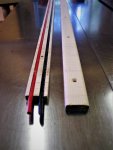
Of course this would mean making a whole new set of strips and replacing them all but to be honest, the factory ones were kind of cheap looking and starting to separate from the headliner anyway. It turned out to be a good excuse to redo something that was kind of bugging me anyway.
If you should ever get the urge to do-as-I-have-done, be aware that 5/16" is the absolute maximum thickness that these strips can be. Any thicker and they will start to interfere with the way the end walls fold up.
So now I had a plan and a nice piece of tiger maple to make the new strips. I warned you this was a deep rabbit hole.
The new wire runs from the junction box under the new ceiling strip to the front folding wall.
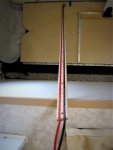
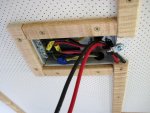
I built a small aluminum disk to hold a rubber grommet and then routed the wire through spiral loom. The wire is going to have to fold here when the roof comes down.
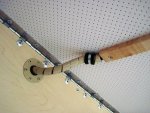
The new wire then follows the original wires behind the trim plywood at the foot of the bed. The original wires get lost behind the plywood panel backing the kitchen cabinets so I routed the new wire through the electrical outlet space in the cabinet, down the corner of the inside of the cabinet in the left front of the camper and finally connect to the original loom that is above the water tank and runs to the battery box. I replaced the original connector on the roof which was becoming a little sketchy with a new stress relieving waterproof box and all the connectors with proper MC4 waterproof type.
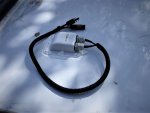
Jeez, looks kind of cruddy in the photo.
With a little extra wire on the roof for the day I get around to building a tilting mechanism for the solar panels, the total run is 26'. That's a long way for a solar cable but with the way the FWC is designed, I don't see any way around it.
I finished this project this afternoon. A quick check and it looks like I've probably gained my amp back. I will only be able do a complete check once I'm travelling but it looks hopeful.
I think that's it for the electrical work.
Ya, good one White Dog.
Okay, I think that's all the electrical work for
now.
At this point, the Grandby is heading back to its little shed for the fall at least. Life and a new granddaughter take priority for a bit. This winter's main project will a resolution to the cause of all this grief, building a new fridge. I think this is going to be an interesting project, so I will go through that build in detail. In the end, I will end up with a camper that will do what I want it to.
Stay tuned for updates and thanks for wading through all this stuff. I hope it was at least entertaining if not useful.

